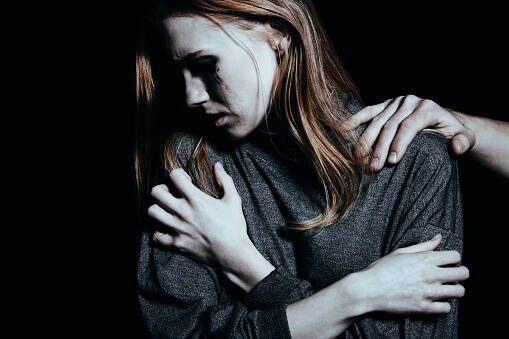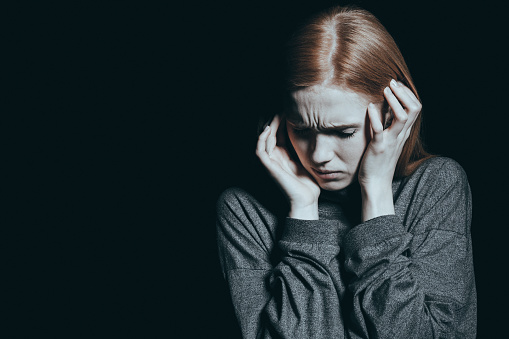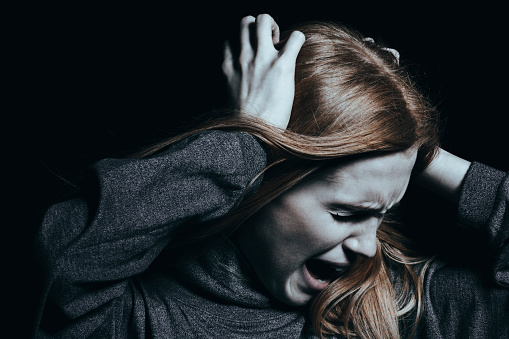- solen.cz - Depressive disorders in selected neurological affections
- psychiatriepropraxi.cz - Mixed affective states - dysphoric mania
- wikiskripta.eu - Anxiety disorders
Anxiety, fear, depression or other symptoms? The causes go back to the past

Anxiety, fear, sadness or other psychological states are manifestations of disturbances in the normal functioning of the psyche. They lead to depression, burnout and, in tragic cases, suicide. Changes in psychological experience are the result of a potential or actual threat. Their causes vary, but they always bring with them suffering.
Article content
Various stressful and traumatic situations, whether current or past, can cause temporary depression but also leave a permanent mark and permanently alter a person's entire personality.
How can the past affect the present?
A person's experience is an abstract phenomenon. Yet it is the support column and reflection of his psyche and behaviour. Experience is a set of perceptions, ideas, thoughts and feelings, the basis of which is determined by the individual's particular experiences. It can change.
Depending on the particular situation you are currently in and the way you see yourself getting out of it, so is your experiencing. But the reason for a bad experiencing does not have to be the current situation.
Experiences from long ago that are traumatic for some reason can also leave a long-lasting or permanent mark on an individual's current thinking and future actions. For example, a disappointment from the past can influence our current thinking (we expect the situation to unfold as it did before).
Fear and anxiety in human experience

Fear and anxiety are important factors in everyone's experience. The difference in these two concepts is in their concreteness.
They can take place separately in a person's mind, they can combine with each other. They can exist as two simultaneous emotions which, by their combination, aggravate the experience itself.
Fear is a subjective negative feeling or emotion that arises because of an impending concrete, potential (assumed) or actual evil (danger).
It is manifested by a negative experience and a whole accompaniment of autonomic manifestations such as pallor, sweating, rapid breathing, rapid heart action, palpitations, trembling, nausea, vomiting or diarrhea.
Anxiety is also a subjective negative feeling or emotion that does not have as concrete a basis as fear.
This emotional state arises from uncertainty, bad premonitions or worst fears. These in some cases may not ultimately be as real as their reality is assumed by the experiencer. Similar to fear, vegetative manifestations of the body occur.
Manifestations of fear and anxiety:
- negative experiencing
- insecurity, fears, psychomotor restlessness
- insomnia, frequent awakenings, nightmares
- increased heart rate, feeling of pounding or pressure in the chest
- increased respiratory rate, shortness of breath (hyperventilation)
- pallor in the face
- excessive sweating (often palms and feet)
- internal trembling (sensation)
- trembling of hands, whole body
- nausea, vomiting, diarrhoea
Depression precedes but also intensifies fear and anxiety

Fear and anxiety are daunting and distressing emotions that are often associated with depression. Depression is the resultant state of prolonged negative factors.
The difference between depression and a transient depressive state is the length of time it lasts and the intensity of the symptoms. The final diagnosis is made only by a psychiatrist.
Depression as a final diagnosis is always a serious condition. It is classified as an affective disorder.
More severe depressive episodes may trigger the development of psychotic symptoms such as delusions and hallucinations. The patient may be completely bedridden due to paralysis of the physical motor system.
Manifestations of depression:
- negative experience
- sadness, crying, crying fits
- insecurity, fears, psychomotor restlessness
- inner trembling (feeling)
- closed-mindedness
- insomnia, frequent waking, nightmares
- food aversion
- nausea, vomiting, diarrhoea
- disturbances in concentration
- memory disorders
- aggressiveness
Apathy versus mania

States of anxiety, fear and depression can cause a person to remain apathetic towards the outside world.
Apathy is manifested by minimal to no reactions to external stimuli. The patient is indifferent to the environment due to lack of emotion and motivation.
Apathy very often occurs in depressed patients who experience great inner sadness. These people feel that their situation has no solution and that no one can understand what they are experiencing.
They close in on themselves, minimally or later not communicating at all with other people. Gradually they lose contact with the world completely.
The opposite of apathy is mania. It occurs transiently in depression or as part of a well-developed manic-depressive disorder.
Mania is a phase of paradoxical, transient excitement. The patient becomes talkative to excessively noisy, social, euphoric, and hyperactive for a while. It can be seen as a kind of short-circuiting, trying to get out of the situation.
Manic-depressive disorder, now also called bipolar affective disorder, is a psychiatric diagnosis and a serious medical condition. It is characterised by alternating mania and depression. It is not, however, a transitory condition that is tied to a particular difficult period, although it may kick-start the illness.
Individual cycles of mood changes last from a few days to weeks for each patient. The cycles are continuous, and sporadically a symptomless phase may occur between them. However, this is the case in a minimal number of patients.
Manifestations of bipolar affective disorder
- Mood disorders
- alternating mania and depression
- regular cycles
- moods do not match the current situation
Aggression as a manifestation of sadness

Sadness and sadness is a negative emotion based on the prevalence of negative evaluation of a particular situation by the individual himself.
It is manifested by psychomotor decline. The sick are inactive, weak, have a feeling of helplessness.
They are hypersensitive, often cry and have states of excessive regret. Internally, they experience feelings of helplessness, loneliness and emptiness.
In some cases, the solution or attempted solution to current problems is manifested by excessive aggression. But there is no way out of the problem.
Aggression can be verbal or physical, directed at objects, animals, self and other people. It is also a manifestation of helplessness in the moment.
Manifestations of aggression:
- verbal insults, intimidation and humiliation of others
- raised tone of voice, shouting
- clenching of fists
- jaw clenching
- aggressive gestures
- destruction of objects
- hurting animals
- hurting oneself
- hurting and attacking other people
- suicide, murder
TIP: Aggression. What do psychologists say about this problem?
Don't let the past destroy the happiness of the moment
The human brain is a complex organ, and human thinking and experiencing is an even more complex phenomenon. Not only do we experience the moment, but also, somewhere from deep within our consciousness, experiences that have already been lived once appear in our minds. These can affect our present experience if we allow them to.
First of all, it is necessary to realise that the events of the past have nothing to do with the present situation. They do not have to be repeated according to the same script. We should learn to say goodbye to the past and not to relive something that no longer exists.
The current situation you are in is new and will never be repeated. That is why you need to let go of all the old fears and deal with the here and now. Maybe things won't go the way you want, maybe you will suffer another blow from life, but everything happens for a reason. We should learn from everything (even the negative). Maybe what you see as a problem now is just a new beginning.

Do I have a problem? How to catch the warning signs
Most people suffering from a psychological disorder are aware of certain symptoms but do not attach enough importance to the condition. They are withdrawn, suffer and gradually lose contact with their surroundings. The presence of the illness is often alerted by those around them.
If the problem is not dealt with, patients withdraw into themselves completely. They indulge in alcohol or other drugs in the belief that this is a temporary solution to the situation, but this can quickly backfire.
What precedes the sequence of events?
One of the first warning signs, even if it is not a symptom, can be considered to be the situation we are in. It is a situation that has disappointed us, that has not worked out the way we wanted, that has hurt us or taken something or someone away from us.
It is any situation that has a negative impact on us. The stress associated with it is like a stepping stone in a cycle of subsequent events and states of experiencing.
These include the death of a loved one, the dissolution of a marriage, the loss of a job, the loss of an existing social status, the diagnosis of a serious or fatal illness to you or a loved one, a serious car accident with consequences such as paralysis, amputation of a limb, and others.
What follows a difficult event?
Fear, sleep disturbances, especially insomnia and frequent night wakings, can be the cause of compulsive thoughts in connection with finding a solution or even forming all sorts of possible conclusions and ideas. Sometimes sleep disturbances are preceded by uncertainty and the question marks associated with it.
The formation of the most terrible conclusions often leads to fear, depression, anxiety. One feels as if one is in a vicious circle from which one cannot get out. The longer this state lasts, the more one succumbs to the idea that there is no solution. Alternatively, one is not identified with the existing solution because it could mean, or does mean, a big change (an unwanted change at the time).
Crying and aggressive outbursts are frequent, and sometimes they are not harmful. They help the person to get the negative feelings out and provide momentary relief.
Of course, this is aggression that is not directed towards oneself or other people. When this line is crossed, it is often a severe pathology that is just a progression of all this.
- a bad, negative, traumatic and seemingly hopeless situation
- compulsive thoughts, the need to constantly think about what has happened
- seclusion, apathy, seeking solitude
- aversion to life and activities, reduced communication
- disturbances in attention and concentration
- sleep disturbances (insomnia, waking, nightmares, bedwetting in children)
- feelings of insecurity, sometimes unfounded fears
- states of depression, anxiety and fear of what will happen or has happened
- crying, crying fits, rage, verbal aggression, directed towards objects, self or surroundings
- abusing various substances as a temporary solution to the situation
- self-harm, suicidal tendencies, suicidality
What can happen if we do not take care of our mental health?
If the primary cause is not addressed or cannot be forgotten, the help of the family, the environment, a psychologist or a psychiatrist is necessary. Not addressing the condition means only one thing, namely its progression. The progression of the condition has serious consequences, affecting significantly not only the patient but also those around him.
The first thing that can occur is a psychological breakdown. The patient feels abandoned and alone, cannot carry out normal daily activities, does not like to eat, does not care for himself. Collapses or bedridden patients are no exception.
Various addictions, such as alcohol abuse, are very common. Alcohol may help at first, but later on, when consumed regularly, it deepens depression and causes other health problems (stomach ulcers, liver cirrhosis, kidney and heart failure). Smokers smoke more than usual, non-smokers often start. In some more serious cases, people reach for psychotropic substances (in the form of medication, drugs).
Poor psychological adjustment combined with genetic predisposition, alcohol and psychotropic substance use, along with other adverse effects, cause the development or outbreak of more serious illnesses such as generalised anxiety disorder, manic-depressive disorder, schizophrenia and various others.
The ultimate and most serious consequence is completed suicide. This is preceded by the suicide of the truly suicidal by withdrawal.
Interesting:
If someone repeatedly threatens suicide and demonstratively cuts their wrists "lightly" or drinks drugs and draws attention to it, that is not a real suicide. In real suicides, the patients are not interested in an "audience". They really want to do the deed, so they don't "inform" those around them about it. Those who talk about it a lot usually just want to draw attention to themselves, or blackmail someone like that.
How to restore peace of mind?
In the past, the treatment of psychological conditions and psychiatric illnesses was mainly medication. Whoever the medication didn't work ended up in a psychiatric hospital, often in solitary confinement and a straitjacket.
Interesting:
Back in the first half of the 20th century, skull trepanation (drilling holes) was used to treat psychiatric disorders. An instrument was inserted into the resulting hole and used to lobotomise the frontal lobe. Doctors at the time thought that by disrupting some of the brain's connections, the patient would be cured. Today, we know that this is not the case. However, in some countries, such as Kenya, skull trepanation is used to remove possession by evil spirits.
Nowadays, medicines are still used, but they are more effective thanks to the continuous scientific development of the pharmaceutical industry. Nevertheless, non-pharmaceutical therapies are preferred (if the situation allows).

Find the root of your problem in the past
Meditations are useful in finding the source of the problem. These clear the mind of negative psychological emotions and help patients to think without them.
They help to answer questions:
- How did the problem occur?
- How did I get here?
- Why did I react this way?
- Was it the right thing to do?
- What made me do it?
It is in the last question that you will often find that fears have led to the deterioration of your situation. The fears are often unfounded and inadequate, and the causes of the fears go back to the past and experiences that have already been lived.
These experiences may have influenced your decision-making in the present. But was your decision the right one? Was it not just fear and anxiety that led you to it?
Remember that allowing fear, anxiety and worry to make decisions for us is not right.
Learn to work with yourself and your illness
Before you start believing in the intractability of the situation and your current condition, learn to work with it. The most important thing is to realise that you are suffering and that it will not stop on its own.
The mind should be trained during periods when it is at rest. This means that when you are having an anxiety attack, fear, panic or depressive episode, it is not appropriate.
Meditation or self-hypnosis and relaxation are appropriate during quiet times. How to do it step by step?
| The initial stages of meditation exercises | Advanced stage of meditation exercises |
|
|
Self-hypnosis and meditation exercises are part of psychological therapies and have become increasingly popular recently. They help to establish peace in the mind, which is important and crucial.
If you have never tried such exercises, it is high time to start. They have helped many patients and people who have had a problem. There are many cases on record where these exercises have even helped people find a solution to a problem.
Interesting:
In the 1920s, American researcher Edmund Jacobs investigated the mind-body connection. He found that negative thinking affects somatic manifestations on the body. If we constantly assume that a situation will turn out negatively, it will. This also applies to diseases that affect us.
How is that possible?
When you imagine that your current situation has turned out well, the solutions that led to it pop up in your mind. Only with a clear mind can you find a solution to the problem! Answers to your questions pop up out of the blue.
Meditácia splneného želania
Interesting resources
Related










